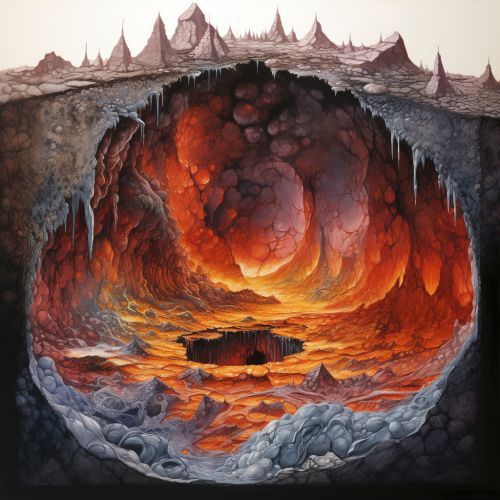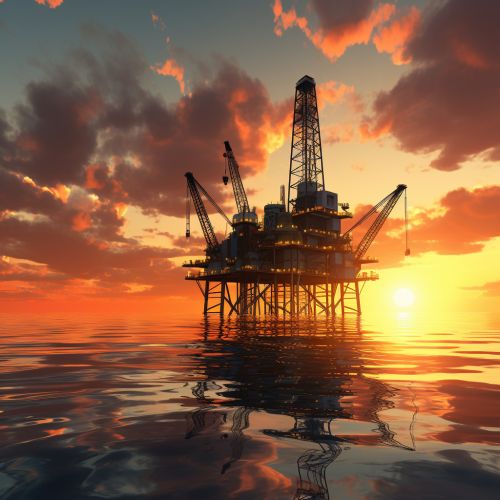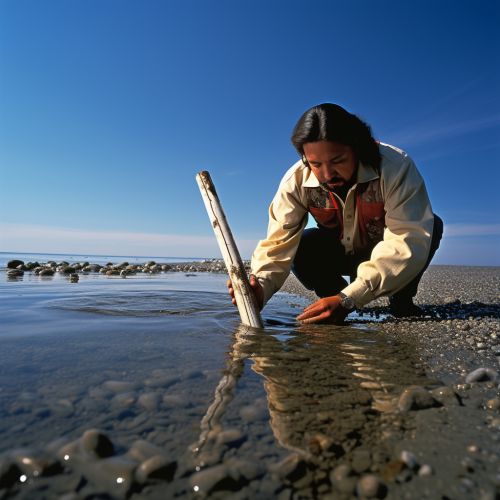Petrology
Introduction
Petrology is the scientific study of rocks and the conditions under which they form. It involves the classification and analysis of rocks as well as the investigation of the processes that led to their formation. Petrology is a sub-discipline of geology, but it also intersects with other disciplines such as geochemistry and geophysics[1].


Types of Petrology
Petrology is divided into three main branches: igneous, sedimentary, and metamorphic petrology. Each branch deals with different types of rocks and the processes that lead to their formation[2].
Igneous Petrology
Igneous petrology focuses on the study of igneous rocks, which form from the cooling and solidification of magma or lava. This branch investigates the formation, composition, and classification of these rocks, as well as the processes involved in their formation such as crystallization and partial melting[3].


Sedimentary Petrology
Sedimentary petrology is concerned with the study of sedimentary rocks, which are formed from the accumulation of sediments. These rocks are studied in terms of their composition, texture, and sedimentary structures. This branch also investigates the processes of sediment transport, deposition, and lithification[4].
Metamorphic Petrology
Metamorphic petrology deals with the study of metamorphic rocks, which are formed from the alteration of existing rocks due to changes in temperature, pressure, or chemical environment. This branch focuses on the processes of metamorphism, the classification and description of metamorphic rocks, and the interpretation of the environmental conditions that led to their formation[5].


Methods of Study
Petrologists use a variety of methods to study rocks, including field studies, laboratory experiments, and numerical modeling. These methods allow them to determine the composition, structure, and history of rocks, as well as the processes that led to their formation[6].
Field Studies
Field studies involve the collection and examination of rock samples in their natural environment. This can include mapping the distribution of rock types, observing the relationships between different rock layers, and studying the structures and textures of rocks in detail[7].


Laboratory Experiments
Laboratory experiments are used to study the physical and chemical properties of rocks. This can involve the use of microscopes to examine thin sections of rocks, the analysis of rock samples using various techniques such as X-ray diffraction or mass spectrometry, and experiments to replicate the conditions under which rocks form[8].


Numerical Modeling
Numerical modeling involves the use of computer simulations to model the processes that lead to the formation of rocks. This can involve modeling the flow of magma, the transport and deposition of sediments, or the conditions of metamorphism[9].


Applications of Petrology
Petrology has a wide range of applications in various fields such as natural resource exploration, environmental studies, and planetary science. The study of rocks can provide valuable information about the Earth's history, the processes that shape its surface, and the resources it contains[10].
Natural Resource Exploration
In the field of natural resource exploration, petrology is used to identify and evaluate potential sources of minerals, oil, and gas. The study of rocks can provide information about the conditions under which these resources formed and their likely locations[11].


Environmental Studies
In environmental studies, petrology can be used to understand the impact of human activities on the Earth's surface. For example, the study of sedimentary rocks can provide information about past climates and environments, which can be used to predict future changes[12].


Planetary Science
In planetary science, petrology is used to study the rocks and soils of other planets and moons. This can provide information about the history and composition of these bodies, as well as the processes that have shaped their surfaces[13].


See Also
References
- ↑ Blatt, Harvey and Robert J. Tracy (1996), Petrology: Igneous, Sedimentary, and Metamorphic, 2nd ed., pp. 1-2, W. H. Freeman, ISBN 0-7167-2438-3
- ↑ Best, Myron G. (2002), Igneous and Metamorphic Petrology, 2nd ed., Blackwell Publishing, ISBN 1-4051-0588-7
- ↑ Wilson, M. (1989), Igneous Petrogenesis, Unwin Hyman, ISBN 0-04-552020-2
- ↑ Boggs, Sam Jr. (2006), Principles of Sedimentology and Stratigraphy, 4th ed., Pearson Prentice Hall, ISBN 0-13-154728-3
- ↑ Yardley, B.W.D. (1989), An Introduction to Metamorphic Petrology, Longman Scientific and Technical, ISBN 0-582-30067-8
- ↑ Winter, John D. (2010), Principles of Igneous and Metamorphic Petrology, 2nd ed., Prentice Hall, ISBN 978-0-321-59674-2
- ↑ Compton, Robert R. (1985), Geology in the Field, Wiley, ISBN 0-471-81959-3
- ↑ Deer, W.A., R.A. Howie, and J. Zussman (1992), An Introduction to the Rock-Forming Minerals, 2nd ed., Longman, ISBN 0-582-30094-5
- ↑ Dufek, Josef and Leif Karlstrom (2010), "From the Cover: Interaction of magma with sedimentary wall rock and its impact on pyroclastic flow hazards", Proceedings of the National Academy of Sciences, 107 (32): 14127–14132, doi:10.1073/pnas.1004677107
- ↑ Marshak, Stephen (2009), Earth: Portrait of a Planet, 4th ed., W.W. Norton & Company, ISBN 0-393-93518-9
- ↑ Hyndman, Donald W. (1985), Petrology of Igneous and Metamorphic Rocks, 2nd ed., McGraw-Hill, ISBN 0-07-031658-9
- ↑ Prothero, Donald R. and Fred Schwab (1996), Sedimentary Geology, 2nd ed., W.H. Freeman, ISBN 0-7167-2726-9
- ↑ McSween, Harry Y. Jr. (1999), Meteorites and Their Parent Planets, 2nd ed., Cambridge University Press, ISBN 0-521-58751-4
